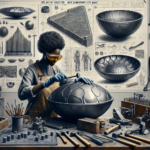The steel drum, also known as the steelpan, has long been associated with the vibrant musical traditions of Trinidad and Tobago. Its rich melodies and resonant sounds have captivated audiences worldwide. In recent years, the handpan has emerged as a popular derivative of the steel drum, gaining considerable attention for its ethereal tones and unique design. Both instruments require a meticulous art and science of tuning to create their iconic sounds. This article explores the fascinating journey from the steel drum to the handpan and delves into the technicalities of their tuning processes.
The Origins of the Steel Drum
The steel drum’s history dates back to the early 20th century in Trinidad and Tobago. Originating from discarded oil barrels, the instrument underwent significant evolution through trial and error by innovative craftsmen known as pannists. These pioneers experimented with different shapes, sizes, and surface treatments to create an instrument that could produce melodious sounds reminiscent of traditional African drumming.
The modern steel drum consists of a concave metal surface with multiple facets or “notes” carefully hammered into it. Each note is meticulously tuned to a specific pitch, creating a chromatic scale that allows for a wide range of musical expressions.
Crafting and Tuning the Steel Drum
The creation of a steel drum begins with the selection of a high-quality steel oil barrel. The barrel is cut, shaped, and carefully hammered to form a concave playing surface. This process, known as “sinking,” requires great skill and precision to ensure the desired curvature.
Once the basic shape is achieved, the next step is to create individual notes by further hammering specific areas of the playing surface. This phase is known as “grooving” and “cutting.” During this process, small indentations are made to delineate the notes, and the metal is gradually stretched and compressed to achieve the desired pitch.
The final stage is tuning. This is where the art and science truly converge. Tuners use hammers, tuning sticks, and electronic tuners to painstakingly adjust the tension and thickness of each note area. The goal is to achieve a pure, harmonious tone with accurate pitch and resonance. The process may involve repeated tuning cycles and minor adjustments until the entire drum is perfectly tuned.
The Handpan: A Modern Evolution
The handpan, also known as the hang drum, is a relatively new instrument that emerged in the early 21st century. Developed by Felix Rohner and Sabina Schärer of PANArt in Switzerland, the handpan shares several similarities with the steel drum but features a distinct design and tonal quality.
Unlike the steel drum’s traditional concave shape, the handpan consists of two convex steel shells glued together. Its surface is adorned with carefully crafted dimples or “tone fields,” each corresponding to a specific note. These tone fields are often positioned in a circular arrangement around a central dome-like structure known as the “ding.”
The handpan produces hauntingly beautiful sounds, making it a popular instrument among musicians and enthusiasts seeking a meditative and immersive musical experience.
Crafting and Tuning the Handpan
The creation of a handpan involves a meticulous and labor-intensive process. It begins with the selection of high-quality steel sheets, which are precisely cut and shaped into the desired convex form. The two shells are then carefully aligned and glued together to form the body of the handpan.
The tone fields are created by painstakingly hammering and shaping the steel surface. This process requires expert craftsmanship to ensure the correct size, shape, and tension of each tone field. The placement of the tone fields and their relationship to the central ding is crucial, as it determines the overall tuning and harmonic structure of the handpan.
Tuning a handpan involves a series of intricate steps. The tuner uses specialized tools and techniques to adjust the tension and thickness of each tone field, carefully calibrating the pitch and resonance. The process requires a deep understanding of acoustics and an artistic sensibility to achieve the desired tonal quality.
The handpan’s unique sound is a result of the complex interaction between the tone fields, the central ding, and the resonant body. Each handpan is a one-of-a-kind instrument with its own distinct voice, making it a sought-after treasure among musicians and collectors.
The Science Behind Tuning
The tuning of steel drums and handpans is a highly specialized science that relies on principles of acoustics and physics. The pitch of a note is determined by the tension and mass of the vibrating surface, while the resonance and timbre are influenced by the shape and size of the playing surface.
When a note is struck, it sets the steel surface into vibrations, producing sound waves that travel through the material and into the air. The frequency of these vibrations determines the pitch, while the amplitude and complexity of the vibrations contribute to the tone’s richness and character.
During the tuning process, tuners adjust the tension and thickness of the steel surface to achieve precise frequencies for each note. This process involves stretching or compressing the metal, altering its shape and density. Acoustically, this means fine-tuning the vibrational modes of the surface to eliminate dissonance and enhance harmonic overtones.
Modern tuners often use electronic tuners and software to measure frequencies and ensure accuracy. However, the final judgment largely relies on the tuner’s trained ear and experience. Achieving a perfectly tuned instrument is both a scientific and artistic endeavor, requiring a balance of technical precision and musical intuition.
The Balance of Art and Science
The tuning of steel drums and handpans exemplifies the harmonious blend of art and science. It requires a deep understanding of acoustics and physics, combined with an artistic sensibility to create instruments that resonate with beauty and emotion.
Tuners often describe their work as a dance between metal and sound, a delicate interplay of hammer strokes, adjustments, and listening. Their craft allows them to shape raw steel into musical masterpieces that captivate and inspire.
Both the steel drum and handpan have become symbols of cultural heritage and modern innovation. They represent the culmination of years of experimentation, craftsmanship, and musical expression. The tuner’s role in this process is both humble and profound, as they breathe life into these instruments, transforming them into vessels of musical enchantment.
Conclusion
The journey from the steel drum to the handpan illustrates the evolution of musical instruments and the profound artistry and science behind their creation and tuning. The meticulous processes involved in crafting and tuning these instruments demonstrate the dedication and expertise of tuners, who bridge the gap between raw materials and resonant music. As both instruments continue to enchant audiences worldwide, the legacy of their craftsmanship lives on, inspiring new generations of musicians and enthusiasts.
FAQs
-
What is the main difference between a steel drum and a handpan?
The main difference lies in their design and sound. The steel drum has a concave metal surface with hammered notes, while the handpan has a convex shape with tone fields arranged around a central ding. The handpan produces more ethereal and meditative sounds compared to the steel drum’s vibrant and resonant tones.
-
How long does it take to tune a steel drum or handpan?
Tuning a steel drum or handpan is a time-consuming process that can take several hours to several days, depending on the instrument’s complexity and the tuner’s expertise. Multiple tuning cycles and adjustments are often required to achieve the desired sound quality.
-
Can electronic tuners replace human tuners?
While electronic tuners and software can measure frequencies and assist in the tuning process, they cannot replace the trained ear and experience of a human tuner. The final tonal adjustments and achieving a harmonious sound rely heavily on the tuner’s expert listening and artistic judgment.
-
Are handpans and steel drums made from the same type of steel?
Handpans and steel drums are typically made from different types of steel. Steel drums are often crafted from recycled oil barrels, while handpans are made from high-quality nitrided or stainless steel to achieve the desired timbre and durability.
-
Can anyone learn to tune a steel drum or handpan?
Tuning these instruments is a highly specialized skill that requires years of practice, training, and a deep understanding of acoustics. While anyone can learn the basics, mastering the art of tuning demands dedication and a refined ear for music.





